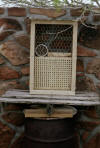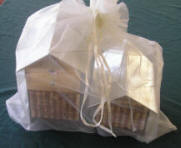![]()
Pollinator Paradise Pollination
Ecology at UI The
Solitary Bee Web
Rearing Solitary Bees
Suppliers References
Bee Gardens FAQ
Links Contact
Us
New Mexico Native Bee Pollinator Project About
Dr. Strickler
Bee Nests and Accessories Bee Photo
Gallery
Trapnesting Wasps and
Bees
![]()
Table of Contents:
1. Nest shelters.
2. Providing mud holes.
3. Alternate bloom before and after fruit bloom.
4. Feeding with sugar water in the
absence of sufficient bloom. (thanks to Steve Dupey, Twisp, WA)
5. Summer storage.
6. Winter management:
removing loose
cocoons, cocoon storage,
mold and dryness.
7. Releasing bees in the spring and
management during bloom.
8. Trap-nesting local bee populations.
9. Links to other sites with management information.
Download a 2009 Osmia management
Calendar to print!
If you have photos illustrating your management techniques,
please submit them! If
appropriate, I will post them on this site.
| 1. Shelters for
orchard bee nests. We favor small hutches with a roof for protecting Binderboard™ nests from the elements. Be sure that the hutch is secured to the ground so that it remains stable even in high winds. Scatter shelters through the orchard for uniform pollination.
Read about the Logan Bee Lab's
"Bee Mail" Shelter, made from plastic mail totes. |
|
| This version has traditional roofing, and sits on a water
tank that creates a mud source for the bees. See another example
below. This shelter is designed to hold enough nests for a population of bees to pollinate about two acres (500 - 600 female). |
|
| This shelter has a plastic roof. The legs rest on the ground, with a piece of rebar pounded into the ground through a hole in the legs to hole the shelter upright. |
|
| A larger roof on this shelter would be better, but the bees liked it. |
|
| Homemade nest in a wooden box, with chicken wire on front to keep the birds away. The chicken wire slows the bees and may be a deterrent to nesting, so don't use it unless you have to. Note the nesting box is placed against a fence that provides some protection from wind. |
 |
| Another wooden box sheltering nests. In this case the box is close to the ground. This works, but bees prefer nests that are higher off the ground. |
 |
| Small nests, hanging from tree branches, can also be scattered throughout an orchard. 49-hole nests are ideal. Hang the nests near the outer edge of the canopy facing east to south-east so the nest receives morning sun. If there are trees with dead branches, dead stumps, or wooden fence posts, these are more attractive nesting sites than live trees. |
 |
| Top of Page | |
| 2.
Providing mud holes for orchard bees. Once nesting begins, orchard bees require a constant source of mud. Dogterom (2002) recommends that the mud source be within 50 feet of the bee nests. Both Dogterom and Bosch and Kemp (2001) recommend digging a hole or a trench for the mud. You may need to put a screen over the mud hole to prevent birds from preying on the bees while they collect mud. |
|
| Blue orchard bees, Osmia lignaria, like to excavate tunnels into the side of the hole. They aren't digging down into a mud puddle, they are digging horizontally into a vertical wall. Find the bee on the side wall of this hole, center of photo. |
|
| There are a variety of ways to provide water to
the mud holes over an extended period if you can't check the holes
frequently. Here are two examples of water sources that we have tried
this season. They both seem to work well. In this version, a large tank is rigged with a siphon system that drips slowly and continuously into a mud hole at the base of a nest shelter. The tank is filled about once a week. |
|
| In this version, a 3 gallon plastic water jug is inverted with the cap off into a large metal pan filled with mud at the base of a mud hole. The jug is refilled every 3 or 4 days. |
|
|
Top of Page
|
|
| 3. Alternate
bloom before and after fruit bloom. Do your bees have an alternate source of bloom to visit before and after fruit bloom ? If not, they may not reproduce to their full potential. Allow weeds like dandelion to bloom, or plant alternative flower sources that bloom before and after fruit bloom. A succession of different varieties of fruit trees and ornamental flowering trees is great. Herbaceous plants like Phacelia tanacetifolia, (lacy phacelia, scorpion weed, fiddleneck) are also good. In Portland, Big Leaf Maple is very popular with our orchard bees. Many other possible flower sources exist, just be sure there is plenty for the bees to forage from so they can continue to provision their cells. Otherwise they will look for nests elsewhere, or they may starve, and will not reproduce. See also, a
technique for feeding Osmia
sugar water when bloom is scarce. |
|
|
Top of Page
|
|
| 5.
Summer storage of nests After fruit bloom when the bees have finished foraging, remove nests from the orchard to a protected place such as a garage, porch, barn etc. When moving nests after bloom, carry the nests with entrance holes facing up so feeding larvae stay on their pollen resources. Nests can also be left outdoors, but be sure that they do not experience excessive hot temperatures, and that they are protected from rain, standing water, and rodents. Cover the nests with fine netting to prevent tiny chalcid wasp parasites from entering the nests and killing the dormant larvae. Netting also prevents summer species of solitary bees and wasps from using empty nests. Chalcid parasites tend to become active in the summer about the end of fruit bloom, so covering the nests can help reduce their populations. Read more about chalcid parasites in Bosch and Kemp, How to Manage the Blue Orchard Bee. Sheer curtains make good protective covers for nests. Or purchase our mesh bags (pictured) to protect your nests. Be sure to tie the bag closed tightly at the top. Check the bag periodically during the summer for adult chalcid parasites that have emerged. If you see them in the bag, this means that your nests were contaminated before they were put in the bag. Try to kill off the adults that are crawling around the bag so they don't re-infest the nest. Keep contaminated nests separate from uncontaminated nests. Use loose cocoon management in the fall to remove cocoons that show signs of chalcids. See Dogterom, "Pollination with Mason Bees" for information about loose cocoon management. |
 |
| Top of Page | |
![]()
Pollinator Paradise Pollination
Ecology at UI The
Solitary Bee Web
Rearing Solitary Bees
Suppliers References
Bee Gardens FAQ
Links Contact
Us
New Mexico Native Bee Pollinator Project About
Dr. Strickler
Bee Nests and Accessories Bee Photo
Gallery
Trapnesting Wasps and
Bees
![]()
Copyright © 2005, Karen Strickler. All rights reserved.
Updated 2/13/08
Updated 1/1/2009